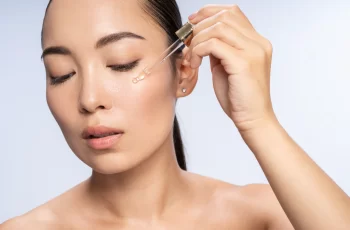
What Is Dermaplaning and How Can It Benefit Your Skin
Dermaplaning is a minimally invasive exfoliating treatment that uses a small blade to gently scrape dead skin cells off the surface of your skin. People often seek dermaplaning to help brighten or smooth textured skin, reduce fine lines, fade acne scars, or remove peach fuzz facial hair.1
Dermaplaning is different than shaving your face because it is more effective at exfoliating the top layer of skin. The treatment removes hair, dead skin cells, oils, and dirt from the skin’s surface.2 It is similar to microdermabrasion—another minimally invasive treatment that uses a device to sand away dead skin cells on the top of the skin.2
A dermatologist (a medical doctor specializing in skin conditions) or an aesthetician (a skincare specialist) typically performs dermaplaning. Med spas and dermatology offices offer this service as a stand-alone or add-on treatment to different facials. As a cosmetic treatment, dermaplaning uses physical exfoliation to improve skin texture and tone.1
Benefits of Dermaplaning
Dermaplanning can benefit your skin as it offers hair removal and exfoliation. As a minimally invasive treatment, it also requires less recovery and causes less irritation than treatments like chemical peels. Dermaplaning offers only short-term skin benefits unless done regularly.3
Smooth and Brighten Skin
Dead skin cells can make your skin appear dry, uneven in texture, and dull. Dermaplaning uses physical exfoliation to remove these dead skin cells, revealing fresh skin and a brighter complexion.4
Exfoliating away dead skin cells also makes the skin feel soft and smooth since rough, damaged skin cells are no longer lingering on the surface.4
Fade Dark Spots
Dermaplaning can help with evening out discolored skin by fading dark spots (hyperpigmentation) caused by age, acne, or melasma. This benefit is largely due to dermaplaning’s exfoliating effect.4
Exfoliating the skin can decrease melanin (skin pigment) production, which causes concentrated dark spots. Exfoliating can also cause melanin-containing parts of cells to spread more evenly throughout the top layer of skin. As a result, dermaplaning may lead to a more even complexion and less visible dark spots.2
Remove Peach Fuzz
In addition to removing dead skin cells, dermaplaning removes fine hairs on your face called vellus hair, also known as peach fuzz.1
Some people want to remove peach fuzz for aesthetic reasons. Removing peach fuzz further smooths the appearance of your facial skin and can help makeup apply more easily and evenly without caking to hair.1
Smooth Fine Lines and Acne Scars
Dermaplanning regularly can help increase cell turnover by removing dead skin cells faster and helping new skin cells reach the skin’s surface.2
This exfoliation process helps make the skin appear smoother and brighter. It also helps reduce the appearance of fine lines and wrinkles by stimulating the production of collagen, which helps plump the skin and fill in lines. This same effect can help reduce the look of acne scars.2
May Improve Skincare Absorption
Dermaplaning regularly may help anti-aging and other skincare products reach their full potential.4
Dead skin cells on top of your skin can prevent the active ingredients in serums and creams from going deeper into your skin. Since dermaplanning removes dead skin cells, it may allow a more direct route for your skincare to absorb into your skin.2
In a lab study where researchers dermaplaned skin samples, the treatment increased the skin penetration of topical medications.5
Who Can Benefit?
Dermaplaning is a good treatment option for people who want to improve skin texture with minimal irritation. Unlike more intense exfoliation treatments like chemical peels, dermaplaning does not entirely remove the top layer of skin.2
Dermaplaning can be gentler on dry, sensitive, textured, or acne-scarred skin, reducing the chance of irritation. It can also help remove dead skin cells that contribute to acne and reduce the appearance of melasma (dark spots caused by excess skin pigment).2
Dermaplanning is not for everyone. Dermaplaning broken and inflamed skin can increase your infection risk and worsen inflammation. People with open skin lesions, inflamed acne or skin, raised scars, skin cancer, and rosacea should avoid dermaplanning.2
The treatment can also spread the herpes simplex virus (HSV-1) to other parts of the face, so you should avoid dermaplanning if you have an active herpes outbreak on your face or cold sores.2
If you have taken acne medications like isotretinoin (brand names include Zenatane, Absorica, and Myorisan) in the last six months, you should also avoid dermaplaning since it can increase your risk of scarring.3
What To Expect
Before professional treatments, always talk with your provider about your skin type and medical history. They must know if you’ve had a cold sore, acne flare-up, hyperpigmentation (dark spots), or other skin conditions to ensure they can perform dermaplaning safely.6
During a dermaplaning treatment, a dermatologist or aesthetician uses a scalpel to scrape away dead skin cells and hair on your face. The scraping sensations shouldn’t be painful but may feel slightly uncomfortable. Depending on your treatment, dermaplaning can take 10-60 minutes.13
After the treatment, they will apply a moisturizer to your skin. Your skin may look red, pink, or slightly swollen (like a sunburn). This will resolve in a few days and shouldn’t require you to avoid activities or stay home from work. Your skin will be extra sensitive to the sun for about a week.31
A new layer of dead skin cells takes about a month to accumulate, so you can typically enjoy benefits like smoother and more even skin for a few weeks.31 Hair will start to grow back, too, but dermaplaning does not make it darker or thicker.
Dermaplaning is a temporary treatment; recurring treatments are necessary to maintain your results. Some people choose to get it weekly, biweekly, or monthly, depending on skin goals and budget.3
What About At-Home Dermaplaning?
At-home dermaplanning kits are different than professional treatments. At-home kits do not use a flat-edged single blade; instead, they use serrated blades. Unlike professional dermaplaning, at-home kits can only mildly exfoliate away dead skin and remove hair. This method is closer to shaving your face than actually dermaplaning.
The shape of at-home dermaplanning blades also puts you at risk of tearing, cutting, or irritating the skin. For best results, always use a clean, sterile blade.
Potential Risks and Side Effects
Dermaplaning often causes minor side effects like redness, skin tingling, and slight swelling. These side effects are common and usually go away within a day. More intense side effects can include bruising, burning, and sun sensitivity. These also typically resolve within a few days.2
Because dermaplanning makes the skin sensitive to sunlight, protecting your skin from the sun after the treatment is essential to avoid developing sun damage and dark patches.21
Dermaplaning is usually safe when performed by an experienced and licensed dermatologist or aesthetician. However, the treatment has risks, especially if you don’t see a professional.
While dermaplaning can help reduce the appearance of dark spots, it can also lead to post-inflammatory hyperpigmentation that can worsen melasma. If done incorrectly, dermaplaning can also lead to scarring or infections.3
Post-Procedure Care
Dermaplanning post-care includes avoiding direct sun exposure, gently cleansing the skin, and keeping your skin hydrated. You’ll want to use a gentle cleanser to wash your face and avoid harsh skincare treatments like retinol for a few days.
Always apply a moisturizer after cleansing to seal in moisture and reduce irritation. Protect your skin with shade, clothing, and sunscreen as part of your aftercare routine to prevent sun damage and dark spots. Wear sunscreen with an SPF of 30 or more for the most protection.3
A Quick Review
Dermaplaning can benefit people with textured skin, fine lines, or acne scars. While results like smooth, bright skin are temporary, consistent dermaplaning can help increase cell turnover and collagen to smooth fine lines and acne scars.
Dermaplaning is a more gentle exfoliating treatment than chemical peels, laser skin resurfacing, or dermabrasion. You will likely notice some redness and swelling after the treatment.
It’s important to see a licensed dermatologist or aesthetician for dermaplaning to avoid risks like scarring, infection, and hyperpigmentation.


